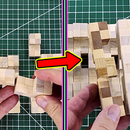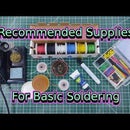Introduction: Cut Square and Odd Shaped Glass Bottles
In this instructable I'm going to show you a method for cutting bottles that's universal, and it can be used to cut any shape of bottle. You can still get flaws with this method, but I'll explain how to minimize them. For example, if you're working with a regular round bottle, I recommend using the method I showed in my previous instructable. The link is here: Bottle-Cutting-With-a-Soldering-Iron
I'm going to demonstrate this method with an oval bottle and a square bottle. If you've seen my previous instructable on cutting bottles, you'll notice this technique is similar. If you haven't seen that one, I recommend checking it out since it goes into more detail.
If you prefer to view this instructable in video form, you can watch it here: https://youtu.be/_jRNuVxLsfE
What you will need:
- A bottle to cut
- A soldering iron
- A marker to mark the bottle
- A glass cutter
Step 1: Mark the Bottle
The first thing we need to do is draw a line with a marker on the bottle where we want it cut. This line will be a visual guide for you to follow.
Fill the bottle with water to the level you want to cut it, then draw a line at that level. But if you prefer, you can free-hand the line or use any method you want to mark it. If the line you're drawing isn't very easy to see, pour the water out and then darken the line before you start the next step.
I did this same thing with the square bottle, but then decided I wanted to cut this one to be cut a little higher. That's why there are two lines on the square one.
Step 2: Score the Bottle
We need to score the bottle a little bit. Since these are odd shaped bottles, I don't have a jig to help with that, so I need to score them by hand. The score line needs to be about an inch or so long. Keep in mind that it may not end up straight, so just try the best you can. And be careful not to use too much pressure when scoring. You don't want to break the bottle in your hands. This score line is a bit hard to see on the camera.
Step 3: Start the Crack
With a hot soldering iron, heat the score line in one spot for about 8-10 seconds, then move the soldering iron a bit and heat it some more. Do this across the entire score line, and past the end of it by about half an inch. Then look and see if the crack has started. Turn the bottle around and start again going in the other direction. It will probably take a while for the crack to start, so repeat this cycle, going in opposite directions each time, until a crack starts.
If a crack doesn't start, no matter how many cycles you do, you may need more heat on that bottle. Instead of using the tip to heat a small part of the score line, use the thicker part of the soldering iron and heat up as much of the score line at once that you can. But keep in mind that if you do this, the crack will form suddenly, and it will most likely stray off the path.
Step 4: Guide the Crack
Once the crack starts, heat the line in front of the crack and the crack should follow. If it stops following the soldering iron, move to the other end of the crack and work on that side for a while.
Go back and forth as necessary until the crack goes all the way around. Remember that when both ends of the crack get close to meeting, a lot of the time they will stop when the two ends are about a quarter inch apart. Usually this means that you're done and the bottle should separate with little force.
This square bottle needed extra heat to get the crack started, and now it has a stray crack in the top portion of the bottle. I've already dragged the crack most of the way around the bottle, so for the last little bit I'm going to pull under the stray crack the best that I can.
Step 5: Separate the Bottle
Now all I need to do is separate the bottles. The oval shaped one cut cleanly and fairly flat. The square one separated easily, but there is a small jagged piece I'll need to spend extra time to sand down. And you can see this piece that is a result of the stray crack.
Step 6: And That's It!
This technique works with any shape or size of glass bottle. Just remember to sand down and polish the sharp edges so you don't get cut. You can go here to see my instructable for that: Polishing-Bottle-After-Cutting
If you want to see the video version of this instructable, you can watch it here: https://youtu.be/_jRNuVxLsfE











